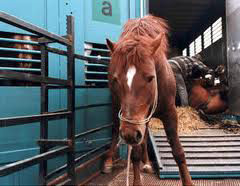Welcome Mat at Slaughterhouse?
By Paula Parisi December 1, 2011Equine welfare advocates were struck a blow in November, when Congress passed a 2012 budget that was, at the last minute, stripped of an amendment that effectively prevented horse slaughter plants from operating in the U.S. This marks the first time since 2006 that this protection has not been part of the budget.
The clause, known as the Moran Amendment for representative Jim Moran (D-VA), banned the federal funding for the inspection of horse meat, which had prevented the slaughter of horses for human consumption.
It was included in the original House appropriations bill as an amendment to the agricultural budget, but did not find its way into the Senate version. The House language did not make it past the conference committee charged with reconciling the two bills. President Obama signed the bill, a portion of the Fiscal Year 2012 Budget, late last month.
Although the move was clearly a blow to animal rights advocates, leading voices in that community say it could galvanize efforts to pass legislation that would create an outright ban on U.S. horse slaughter and the export of U.S. horses for slaughter purposes. Currently pending in the House and Senate right now is the American Horse Slaughter Prevention Act (HR-2966 and S-1176).
“This has energized our base like nothing in a very long time,” Equine Welfare Alliance president John Holland said. “At the EWA we have taken the gloves off! We are pursuing several different avenues.”
“It’s easy to feel discouraged at times like this, and I can tell you we’re disappointed, but we’re going to be redoubling our efforts at getting the American Horse Slaughter Prevention Act passed,” said Kate Wall, the Humane Society of America’s executive in charge of grass roots outreach. “It’s time to take a deep breath and roll up our sleeves and work towards another solution to prevent this barbaric practice of slaughtering these iconic creatures.”
While the main obstacle to reopening horse meat plants has been removed, it is not a slam dunk that slaughter facilities will be operational in the U.S. anytime soon. Several states, including California, have enacted bans against the highly polluting outfits. Also, since there is no U.S. aftermarket for horsemeat―considered a delicacy in Europe and Asia―the companies that are successful in this area are foreign, and there is no indication they’d be willing to return to the U.S., where they know from past battles that public sentiment against horse slaughter runs strong.
By defunding government inspection of horse meat destined for human consumption, the Moran Amendment effectively made it impossible for slaughter plants to operate in the U.S. It was a continuation of the Ensign-Byrd Amendment, enacted in 2005 for the same reason.
The fact that the amendment was removed in a year when pressure to reduce government expenses was intense says a lot about the determination of pro-slaughter interest groups to reintroduce the concept to the agricultural mainstream.

Representative Jim Moran, D-VA, authored legislative language that forced the closure of U.S. horse slaughter plants in 2007.
It is estimated that were horse meat inspections to go back into effect, they could cost taxpayers between $2-5 million per year. The last two U.S. horse slaughter plants closed in 2007. That did not prevent an estimated 100,000 U.S. horses from being shipped annually to Mexico and Canada for slaughter―the same number as killed in the U.S. during years of slaughterhouse operation. The data is cited by slaughter advocates who say the ban has done nothing to prevent U.S. horses from meeting a brutal fate, and has heightened the cruelty by imposing a lengthy and uncomfortable journey on the slaughter-bound animals.
The congressional shift comes on the heels of a widely discredited report released by the U.S. Government Accountability Office this summer. Positioned as a reasoned “study,” the 65-page document claims to make a financial case for re-opening U.S. horse slaughter plants, but critics said the piece lacked hard data, relying instead on rhetoric and anecdote to make its case.
“The agricultural committee requested that report fully knowing it would come to this,” Holland said. “They wanted ‘cover,’ so they could go back to their constituents and say, ‘Listen, I know you are concerned about horses, but the Government Accountability Office is telling us we have to do this.’”
Equine activists reacted last month by immediately submitting to President Obama a petition demanding support for the American Horse Slaughter Prevention Act. “We want legislation to be implemented to ensure that American horses, both domestic and wild, will never face the horror and cruel, predatory business of horse slaughter,” said R.T. Fitch, author of the book Straight from the Horse’s Heart, and one of the signatories.
Administration Under Secretary of Food Safety for the USDA, Dr. Elisabeth Hagen, responded with a letter that stated, in part, “Recently Congress lifted a ban prohibiting federal funding for the inspection of horses, which had prevented the slaughter of horses for human consumption for the past five years.
“While Congress has technically lifted the ban, USDA does not expect horse slaughter to resume in the near term as a number of federal, state and local requirements and prohibitions remain in place. Furthermore, there have been no requests that the Department initiate the authorization process for any horse slaughter operation in the United States at this time.”
Among the causes of concern for horse advocates is the fate of the thousands of wild horses the Federal Bureau of Land Management has removed from the range, largely at the insistence of cattle ranchers, who license the land from the government and see the horses as a nuisance, infringing on feed and water resources. Currently housed in “holding pens” at a cost of millions of dollars per year to taxpayers, there is fear they’d be put to slaughter if it were to return to the U.S.
Short URL: https://theequestriannews.com/?p=7045



